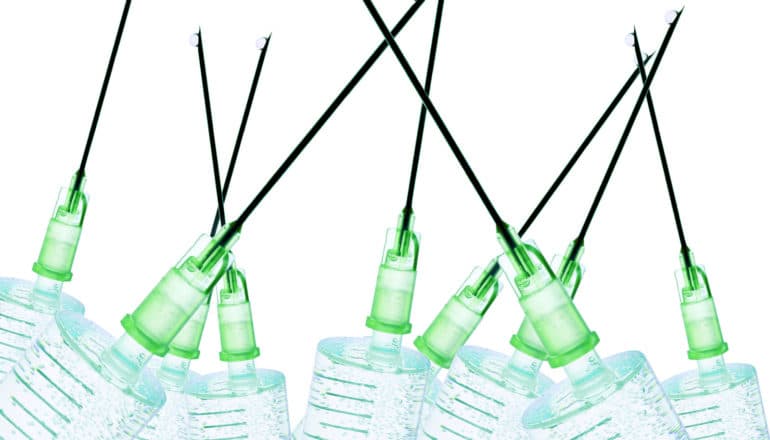
A new mathematical model describes how highly concentrated antibody solutions separate into different phases, similar to an oil and water mixture.
This separation can reduce the stability and shelf-life of some drugs that use monoclonal antibodies, including some used to treat autoimmune diseases and cancer.
Scientists from Penn State and MedImmune, LLC (now AstraZeneca) investigated the thermodynamics and kinetics—the relationships among temperature, energy, and the rates of chemical reactions—of the phenomenon with a method that allows for the rapid study of multiple samples at once. A paper describing their model appears in the journal Proceedings of the National Academy of Sciences.
Like a vinaigrette
Many drugs today are stored as solids and dissolved in IV bags for delivery to patients, but the pharmaceutical industry has been moving toward drugs that can be stored as liquids and given via a shot. Some of these drug solutions, like those used to treat autoimmune diseases and some cancers, contain high concentrations of monoclonal antibodies—proteins that attach to foreign substances in the body, like bacteria and viruses, flagging them for destruction by the patient’s immune system.
“Highly concentrated protein solutions can separate into different phases, like a vinaigrette salad dressing separating into layers over time,” says Bradley Rogers, graduate student in chemistry at Penn State and first author of the paper. “Phase separation is one of the pathways that makes these drugs unstable and unsuitable for use. The classical method to understand this process involves manipulating the temperature of one sample over time. We used a temperature gradient microfluidics platform to quickly look at many temperatures simultaneously.”
Antibody solutions
An antibody-rich solution begins as a clear liquid at room temperature, but as the solution cools, cloudy droplets begin to form. Over time, the droplets settle to the bottom, with dilute liquid remaining on top, making the sample appear clear. The team used an innovative device that creates a range of temperatures across a temperature gradient and used a technique called dark-field imaging to measure how quickly this process occurs. Then the team calculated a variety of parameters to better understand the thermodynamics and kinetics of the system, including the temperatures at which phase transitions occur and activation energies, the amount of energy it takes to go from one phase to the next.
“We observed that the rate that a solution separates into two phases has a strange dependence on temperature,” says Rogers. “This relationship is much more complicated for concentrated antibody solutions than it is for other systems. We spent a long time trying to make sense of the data, but we eventually developed a model that explains what we are seeing.”
Cooler and cooler
The model describes how antibody molecules stick together as the temperature decreases, forming droplets that grow as additional molecules join. This reversible process happens more and more quickly with decreasing temperature, because the solution gets increasingly saturated with free antibody molecules. Then, as the solution continues to cool, droplets stick to other droplets and settle to the bottom. At even colder temperatures, the solution forms a gel and cannot complete the separation, even over the course of a month.
“In a single experiment, we can visualize the homogenous clear solution, the cloudy solution as droplets begin to form, the phase-separated liquid, and the gel,” says Paul Cremer, chair in natural sciences at Penn State and senior author of the paper. “Previous research described these different states, and our model describes the mathematics and temperature-dependent kinetics behind what we believe is happening.”
Next, the research team plans to investigate if their model can explain phase separation in other systems. They also plan to test whether parameters gathered from this type of experiment can predict stability and shelf-life of therapeutics.
“If these parameters can help us predict stability and shelf life, we may be able to select better drug candidates,” says Rogers. “We may also be able to determine the ideal solution properties for a promising drug candidate to keep it stable.”
MedImmune LLC (now AstraZeneca) supported the work, as did the National Science Foundation.
Source: Penn State
The post How temp makes some drugs separate like salad dressing appeared first on Futurity.
from Futurity https://ift.tt/2K9hFT2
No comments:
Post a Comment